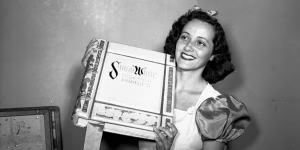Since 2016, over two dozen children’s books written from either side of the aisle have tackled the difficult task of explaining the current administration’s policies to young readers. Some of the most interesting ones purchased for the research collection of the Cotsen Children’s Library are surveyed here.

President Donald J. Trump Paper Dolls. Dover Publications, 2017. (Cotsen)
Dover Books captured the glamour of Donald John Trump’s inauguration in a commemorative paper doll book. The new First Lady’s pale blue Ralph Lauren ensemble and other Trump women’s designer gowns outshine the President’s dark blue coat, business suit, and long red tie.

The Trump Family Story. [Middletown, 2021]. (Cotsen)

Donald Trump: America’s 45th President. Peachtree City: Carole Marsh/Gallopade International, ©2016. (Cotsen)
Donald Trump the 45th President (2016) is the only example of a fun-fact introduction to this occupant of the White House. It was produced by Gallipolade International, an educational publishing company founded by Carole Marsh that produces materials supporting curriculum in social studies. Before diving into sections describing the Electoral College, the line of succession, and the history of Camp David, young readers learn that Donald Trump loves See’s Candies, scrapes the toppings of the crust of his pizza, and styles his hair after Melania cuts it. Informative activities include quick quizzes, a form for drafting a letter to the chief executive, and a maze (help the Secret Service find the president who’s gone to make a snack in the kitchen).

Donald Builds the Wall! Washington, DC: Regnery Publishing, [2019]. (Cotsen)

Trump and the Dragon. [USA]: Great American Children’s Books, [ca 2017]. (Cotsen)

A Lib I Am! [USA], c2017. (Cotsen)

Dear Mr President. London: Templar Books, 2019. (Cotsen)
A brief pause for Dear Mr. President (United Kingdom: Templar Books, 2019), a picture book whose author/illustrator made an honest attempt to break down one of the signature political initiatives of the Trump administration in an accessible way without oversimplifying its complexity. Sam has decided that his big brother, with whom he shares a bedroom, sounds like an undesirable according to President Trump’s definition. Building a wall sounds like a good solution to the problem of his brother’s thoughtlessness, so Sam writes a series of letters to the American president telling him about his construction project’s progress. During family discussions Dad has a word with his older son and hostilities begin to subside. Sam comes around to the idea that “communication and negotiation are always preferable to separation,” especially now that he knows that the great walls of history didn’t attain their builders’ objectives. It’s probably no coincidence that this gentle, common-sense story illustrated by Anne Villeneuve is the work of New Zealander Sophie Stier.

Donald Don’t Grab that Pussy. [USA], c2017. (Cotsen)

Take a Trump. [USA, ca 2017]. (Cotsen)

The Very Angry Caterwauler. [USA], c2017. (Cotsen)

If You Give the President a Twitter Account. New York: Humorist Books, 2019. (Cotsen)
Laura Nemeroff’s famous series has been taken of advantage for Trump parodies at least twice. Matt Lassen’s If You Give the President a Twitter Account (New York: Humorist Books, 2019), is as much an indictment of the role pundits on network and cable television feed into the 24-hour news cycle that allows Trump to manipulate coverage to his advantage, while Trump’s less presidential traits are the butt of Fay Kanouse’s If You Give a Pig the White House (New York: Castle Point Books, 2019).

If You Give a Pig the White House. New York: Castle Point Books, 2019. (Cotsen N-002892)
It’s a pity that Kanouse and her illustrator Amy Zhing have not yet produced the three other books advertised on the dust jacket flap: If You Put a Snake on the Supreme Court, Ivanka and the Terrible, Horrible, No Good Very Bad President, and Oh, the Prisons You’ll Go To.

Goodnight Trump. New York: Little, Brown and Company, 2018. (Cotsen N-002893)
Possibly the most trenchant picture book parody about the Trump administration is Goodnight Trump (Boston: Little Brown, 2018), unsurprisingly the work of Erich Origen and Gan Golan of the New York Times. The text and pictures skillfully weave together details about the president’s self-promotion, alignment of the country’s interests with those of authoritarian regimes, trade policies, exploitation of the tax laws, immigration policies, etc. to crest in an apocalyptic vision of Washington being swept clean: “Goodnight global climate shock / Goodnight ticking Doomsday Clock / Good night allies thrown under the bus / Goodnight “the best people” / Goodnight cover-up brush / … / Goodnight swamp / Goodnight troll / Goodnight upended Old Glory / Goodnight hole in the soul / Goodnight to the lies and the truths he evades/ Goodnight Trump and his whole sad charade.”

Trumpty Dumpty Wanted a Crown. San Francisco: Chronicle Prism, [2020]. (Cotsen N-002895)
“Dumpty suggests disinfectant injections/ To save us from COVID’s pernicious infections, / Or a frontal attack to defeat it outright / By blasting our lungs with salubrious light, / A blithering idiot, gone round the bend: / When in the world will this lunacy end?”

Don’t Be Like Tump. [USA, 2021]. (Cotsen)
Picture books about the tumultuous transition after the election, culminating in the January 6th riot in the Capitol Building, could appear within months. No account of the Trump presidency from the left or right should omit it, but who will touch it? That remains to be seen. This motley crew of picture books and their even scruffier friends, which didn’t make the final cut, will surely give future historians pause.
Note: Readers now may react very differently to this post than when it was first published in 2021. A new round of authors may have been inspired by events since the inauguration last January to comment via picture books….














